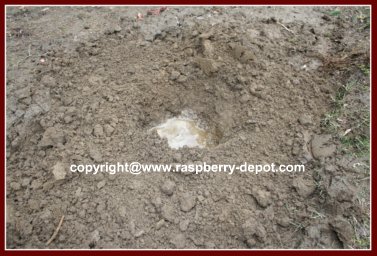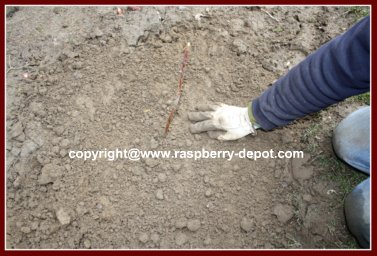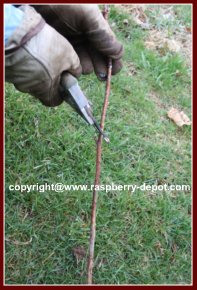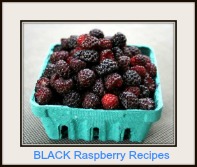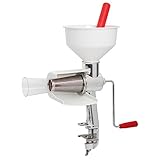Transplanting Raspberries
When and How to
Propagate / Divide / Transplant
Red Raspberry Plants
Transplanting Raspberries or dividing or propagating red raspberry plants, to increase the size of your raspberry patch, is a simple process.
*FTC Disclosure: As an Amazon Associate I earn from qualifying purchases with no extra cost to you
*FTC Disclosure: As an Amazon Associate I earn from qualifying
purchases with no extra cost to you
Increasing the size of your raspberry patch is one reason you may be wanting to divide your plants. Other reasons may be that your patch is becoming unmanageable and over-grown and hard to maintain and harvest.
Or, perhaps you wish to divide your bounty with a friend or a neighbour who is anxious to grow their own raspberries too!
Since raspberry plants are "self-propagating" you will, no doubt, be using this division process from time to time!
When is the Best Time to Transplant Raspberries?
The very best time to transplant raspberry plants is in early Spring or in late Fall /Autumn, when the plants are in a "dormant" state.
Due to the fact that the plants are not actively growing during this time of dormancy, they are more equipped to manage the stress associated with the division process.
Do not transplant these plants in the summer; you will negatively affect your raspberry harvest by prematurely uprooting the fruiting canes.
In Early Spring - as soon as the soil around the plants is workable, and before any signs of active growth.
In Late Fall /Autumn - after the plants have gone dormant for the winter, and the raspberry canes have finished bearing fruit and have shed their leaves.
Red Raspberry Plants ("Original Plants/Canes"), produce young canes from their roots during the summer, but at the same time also produce some long underground suckers ("surplus suckers").
The raspberry plants, ("suckers"), which grow from these are used for propagating /transplanting raspberries.
It is these raspberry "sucker plants" that are removed from the original raspberry canes/plants during late Fall /Autumn or early the following Spring.
Scroll down for step-by-step instructions for how to transplant raspberries.
Here are simple step-by-step instructions for the home-gardener for how to divide and transplant red raspberry plants.
Note - If you are looking for information about propogating Black or Purple Raspberry plants,
GO to How to Propogate Black/Purple Raspberries
How to Transplant Raspberries
Step #1
With the help of a garden fork, these surplus sucker canes/plants can easily be lifted so that the roots are exposed.
Make sure that one or two root buds are visible on the roots of the young canes. Use these canes only.
Carefully separate the young raspberry plant from the original plant, using sharp pruning shears.
Step #2
Immediately transplant the young raspberry cane/plant in prepared soil.
A loam soil with a high organic matter content is the ideal soil in which to transplant raspberry plants. The site should have full sun and have good air circulation for disease prevention.
Make a hole, about 6 - 8" deep with a diameter slightly larger than the root system of the young cane, and fill the hole with water.
Insert the raspberry cane/plant into the hole, adjusting the planting depth so that the crown of each plant is just below ground level. Back-fill the hole with loose soil, and gently tamp the soil around the plant to keep it in place.
Step #3
After planting, using sharp pruning shears, cut the cane down to a bud about 9 - 12 inches above the ground. Make the cut just above a bud.
The newly transplanted raspberry plants should be watered regularly after planting. Do not allow the plants to dry out. In periods of drought, make sure that the soil is constantly kept moist.
Repeat the above process for each red raspberry cane/plant that you wish to transplant.
If you follow these easy steps for transplanting raspberries, over time, you will be able to have a raspberry patch as large as your heart desires, or your property will allow!:)
Here (below) are examples of good pruning shears for pruning raspberry plants/canes, available for purchase online at *Amazon.com.
The available "holster" for the pruning shears, is a very handy accessory to have, because you often need two hands when using the shears.
With this handy holster you will have a place to safeguard your shears when you do!
These gardening "must-haves" make great gifts too!
For more detailed information about growing raspberry plants, here follow links (or use the navigation bars) to pages which will be helpful in your berry growing endeavours!
Raspberry Plant CARE
(Fertilizing/Watering/Spraying/Sun Requirements)
TOP of
Transplanting Raspberries
HOME to
Raspberry Depot Homepage
©2010-2025 Raspberry-depot.com - All Rights Reserved Worldwide
No Reproduction Permitted Without
the Express Written Consent of the Site Owner
Special Occasion Recipes
♥ Valentine Recipes ♥
Pancake Day Recipes
Easter Recipes
Mother's Day Recipes
Father's Day Recipes
Thanksgiving Recipes
Christmas Recipes
New Year's Eve Recipes
This Knife Sharpener
is one of the
Most USEFUL
Kitchen
Tools
that I have
EVER
Purchased
I've been using
the same
Knife Sharpener as
the One Below for
Well Over 10 Years!
⇩
